Brussels sprouts: description with photo and cultivation technology
Brussels sprouts are still rarely found in summer cottages, despite their excellent taste and nutritional qualities. This low popularity is due to the long vegetative period and some of the features of care. But, knowing all the nuances of growing Brussels sprouts, you can get a large harvest of healthy and tasty heads of cabbage.
The content of the article
What does Brussels sprouts look like?
It is the youngest vegetable crop from the cabbage group and has an original appearance. Brussels sprouts are a biennial plant that in the first year forms a tall (up to 60 cm) dense stem with a leaf rosette in the upper part.
The leaves that make up the top have long, thin petioles and a bubbly, uneven surface in different shades of green. In the axils of the leaves of the central stem, numerous small heads of cabbage with a diameter of 3-4 cm develop. One plant can have from 20 to 70 such fruits, and their total weight reaches 300-600 g.
In the second year, inflorescences and seeds are formed on the culture, which remain germinating for 5 years.
In the photo - Brussels sprouts.
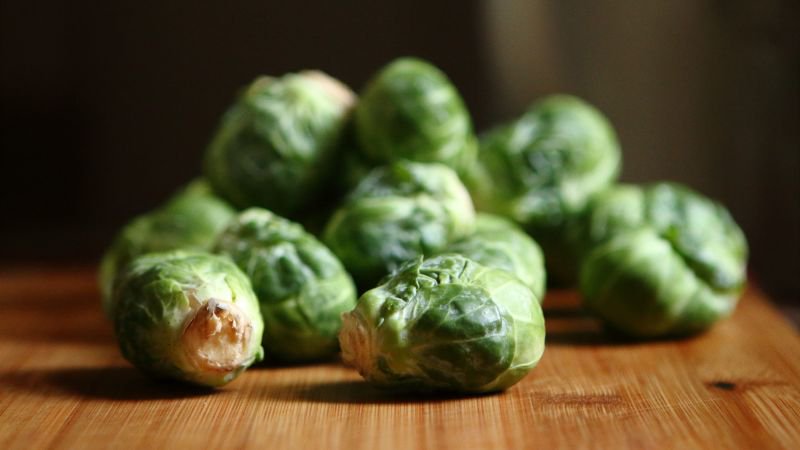
Growing seedlings
Brussels sprouts are best grown in seedlings, the technology of which is familiar to most summer residents.
Seed preparation
To obtain healthy and strong shoots, the seeds are pre-prepared before sowing in the ground:
- The seed is placed first in a container with hot water (50-60 ° C) for 15 minutes, and then in cold water for 1-2 minutes.
- The seeds are kept in growth stimulants ("Kornevin", "Epin") for 12 hours.
- Remove, washed and refrigerated for 24 hours.
- Dry slightly, discard damaged and too small ones and begin sowing into the soil.
In nurseries, they purchase already prepared seeds that have undergone disinfecting and stimulating procedures in an industrial environment. Such planting material is more expensive, but immediately suitable for sowing.
Soil selection
The best nutrient substrate for cabbage seedlings is considered to be a mixture of equal parts of turf, peat and sand. Before sowing, add 3-4 tbsp. l. wood ash and 0.5 tbsp. l. superphosphate (per 1 kg of the mixture). Containers or boxes for seedlings are filled with this soil and additionally disinfected with a solution of potassium permanganate. The optimum pH is 6-7.
Reference. It is better not to use soil from the garden plot and humus, since they contain a rot pathogen.
How to plant seeds
Sowing cabbage seeds is carried out in late March - early April. Separate containers are best for this, but large containers or boxes will work as well. In this case, the optimal distance between the seeds of the crop will be 3-4 cm. They are planted at a shallow depth of 2 cm. Early germination is characteristic of the seeds of Brussels sprouts - the first sprouts hatch after 4-6 days.
Reference. The highest quality and strongest seedlings are obtained when grown on a closed loggia or in a heated greenhouse, since the optimal temperature regime is ensured in these rooms.
Seedling care
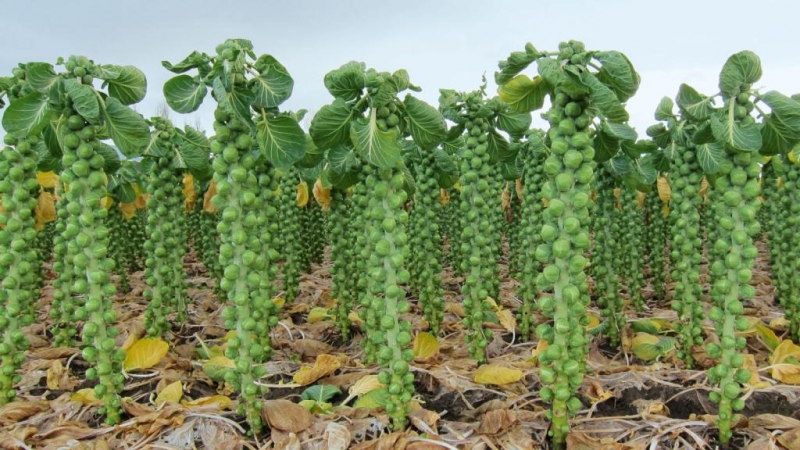
Taking care of young seedlings includes several important procedures:
- Maintaining the temperature regime. Dabout the appearance of the first shoots, the optimum temperature is + 20 ° C. When the seedlings come up, at night - + 6 ... + 8 ° C, during the day - about + 20 ° C. The room is ventilated.
- Illumination. Containers with seedlings are placed in a bright place, but without direct sunlight.
- Watering. The seedlings are not watered for the first two weeks, and then regular watering is provided. The soil must not be dry.
- Top dressing mineral fertilizers. It is recommended to apply fertilizers twice during the growth of seedlings. The first feeding is carried out during the appearance of the second true leaf in the plants. To do this, a mixture of 20 g of urea, 10 g of potassium fertilizers and 40 g of superphosphate is dissolved in 10 liters of water. The second feeding is carried out 10 days after the first, and the doses of minerals are increased by 1.5 times. After each fertilization, the cabbage is watered abundantly.
- Picking. It is carried out in the case of placing seedlings in large common containers about 1.5 months after sowing the seeds, when 4-5 full-fledged leaves are formed in young shoots. Together with the earthy clod, the plants are moved into separate containers.
Seedlings of Brussels sprouts do not tolerate thickening very well, so it should not be allowed.
It is interesting:
Proven ways to store Brussels sprouts fresh, frozen and canned for the winter.
The most delicious pickled Brussels sprouts recipes for the winter.
In what form and how to properly freeze Brussels sprouts for the winter in the freezer.
Open ground transplant
It is recommended to plant Brussels sprouts in open, light places, preferably on the southern or southeastern sides of the site. The composition of the soil does not matter much, and neutral and slightly acidic soils are considered ideal.
When to plant
After 50-60 days after germination, when 5-6 leaves appear on the plants, they are moved to open ground. This period usually occurs in the early days of summer.
How to plant correctly
For planting seedlings in open ground, it is better to choose a cloudy day or evening time.
Young plants are placed according to the scheme 60 × 60 cm in holes that are larger than the seedling capacity. Carefully roll over each sprout along with a lump of earth, sprinkle it with soil, compact and water it well. The plants themselves are buried so that their lower leaves are at the level of the soil. This contributes to the rapid formation of the root system.
Important! Untimely planting of seedlings and too close location of cabbage bushes leads to a decrease in yield.
How Brussels sprouts grow
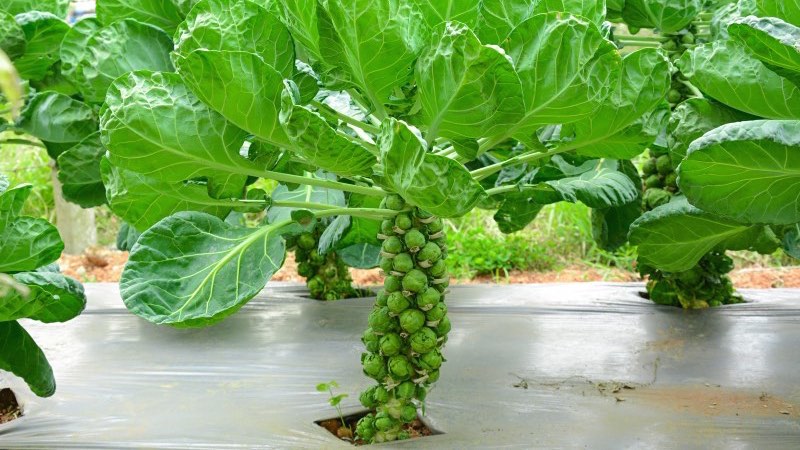
In its growth and development, this vegetable culture goes through several stages, each of which is given a certain time.
Staged growth from planting to harvest
The whole process of growing Brussels sprouts includes the following stages:
- preparation and sowing of seeds;
- care for cabbage seedlings;
- transplanting plants into open ground;
- the first formation of heads of cabbage - about 110-130 days;
- obligatory pinching at the end of August;
- harvest at the end of September.
Ripening terms
Depending on the variety of this vegetable crop, among which there are early-, mid- and late-ripening, the period from the first shoots to full maturation is 130-180 days.
Outdoor care for Brussels sprouts
Cultivation of Brussels sprouts is not much different from the cultivation of ordinary white cabbage. The main feature is that it does not need hilling, which can lead to rotting of the lower heads of cabbage. The pinching procedure is very important for her.
Watering and feeding
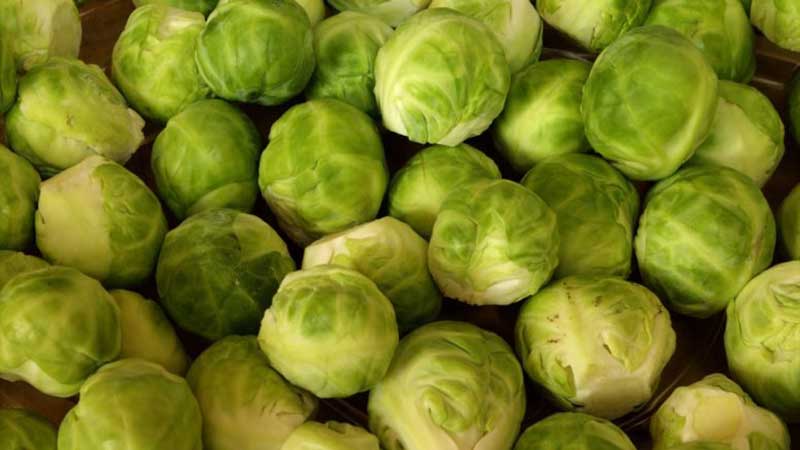
This vegetable crop is hygrophilous and needs regular watering. They are carried out weekly, consuming 30-35 liters of water per 1 m² before the appearance of heads of cabbage and 40-45 liters after the start of their formation. Brussels sprouts do not tolerate drying out of the soil, so the irrigation rate for it is at least 20 liters per 1 m².
After watering, cabbage bushes are loosened and weeded.In rainy periods, with high air humidity, the frequency of watering is reduced to prevent excessive stagnation of water in the root part of the plants. In hot weather, not only the rows are moistened, but also the paths between them. The evaporation of water helps to reduce the high air temperature. In the morning and evening, it is better to water over the leaves.
Reference. To ensure long-term preservation of moisture in the soil, the beds are mulched.
Fertilizers applied to Brussels sprouts help improve yields and health. For the entire time of cultivation in open beds, this culture needs two mineral dressings. If the soil on the site is highly fertile, one-time feeding is done.
Fertilizers are applied for the first time 8-12 days after planting young bushes in open ground. Apply "Nitrofoska", dissolving 15 g of the mixture in 10 liters of water. 5 liters of water composition are consumed per plant.
The second feeding is carried out at the beginning of the formation of heads. Combine 25 g of superphosphate, 23 g of potassium sulfate and 10 g of "Nitroammofoski", dissolving the mixture in 10 liters of water. One bush requires 1.5 liters of composition. Also, manure infusion is used as fertilizer for Brussels sprouts, which is diluted in a ratio of 1:10.
Topping
For Brussels sprouts, the pinching of the apical growth point is mandatory. The leaves of the top of the plant are left. The pinching is carried out at a time when the heads of cabbage are in the phase of active formation, usually in late August - early September.
The procedure stops the growth of the stem and promotes the formation of more heads. Leafy tops without heads of cabbage in underdeveloped bushes cannot be pinched. This will cause decay of the cut site and the death of the entire plant.
Attention! Untimely pinching of cabbage leads to the fact that instead of heads of cabbage, a bush of tops is obtained.
In late September - early October, the time comes for the second pinch, when the entire top of the plant is cut off.
What to do if the cabbage does not tie
Sometimes the plant is in no hurry to tie heads of cabbage. Main reasons:
- an excess of fertilizers or, conversely, a lack of them;
- untimely pinching of the bush;
- too hot weather;
- very dense planting of plants, causing a lack of light and nutrition;
- illiterate watering;
- excessive acidity of the soil.
Do I need to pick leaves from Brussels sprouts when tying a head
The tops of the cabbage crop are cut off only after the formation of heads of cabbage in the following cases:
- it touches the ground surface;
- damage is observed on it;
- it becomes faded, yellowed, lethargic;
- its growth makes it difficult for air to reach the heads of cabbage.
Leaves are torn off by hand or with a knife in dry weather, so that the resulting wounds heal faster.
Reference. Brussels sprouts need to remove the lower leaves usually 1-1.5 months before harvest, if the above factors are not present.
Care in August
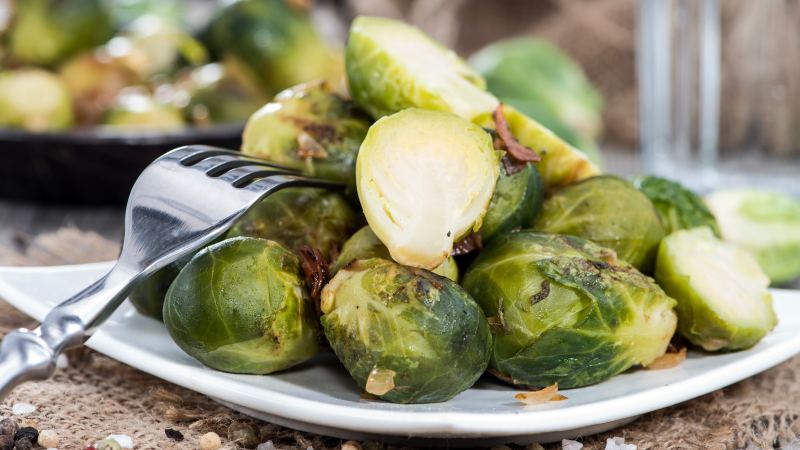
In August, one of the important periods in the development of cabbage culture begins - the active formation of heads of cabbage. At the end of the month, the bushes are pinched in time. If there are few heads of cabbage, it is worth postponing this procedure to the beginning of September. At this time, plants need regular and abundant watering.
Read also:
Conclusion
It is possible to grow a high-quality harvest of Brussels sprouts even in the middle climatic zone. It is necessary to correctly follow all the recommendations for planting and caring for seedlings and adult plants in the open field. Competent agricultural technology of Brussels sprouts will allow you to get a plentiful and high-quality harvest.